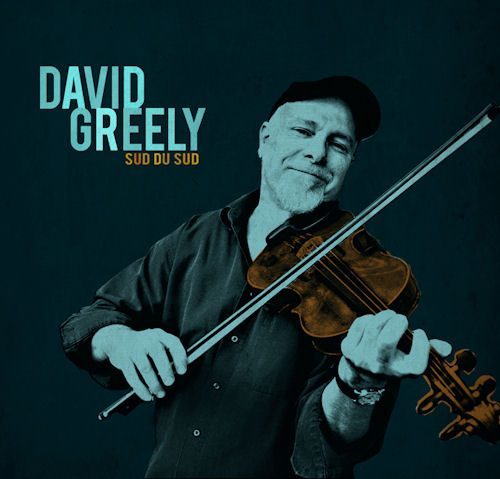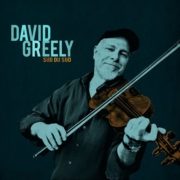DAVID GREELY – SUD DU SUD
ARTIST: DAVID GREELY
TITLE: SUD DU SUD
LABEL: GIVE AND GO RECORDS
RELEASE DATE: 2009
Strings Attached: David Greely –
Me and Denis McGee, and a lot more
You have to know where the party is to find this music. Welcome to our kitchen. Put away your earplugs for awhile. – David Greely
 If you take the accordion out of Cajun music and take the Cajun music out of the dance hall, what will you get? Ace fiddler, David Greely, an original member of the Mamou Playboys, lets us in on a secret most Cajun music aficionados know about, but rarely get to hear, at least in recordings or outside of Louisiana. With Sud du Sud (South of South), the fiddle has a life of its own and in a setting such as this, one gets to experience the instrument away from the din of the Fais dodo.
If you take the accordion out of Cajun music and take the Cajun music out of the dance hall, what will you get? Ace fiddler, David Greely, an original member of the Mamou Playboys, lets us in on a secret most Cajun music aficionados know about, but rarely get to hear, at least in recordings or outside of Louisiana. With Sud du Sud (South of South), the fiddle has a life of its own and in a setting such as this, one gets to experience the instrument away from the din of the Fais dodo.
With help from local Louisiana talent: Joel Savoy, Sam Broussard, and Gina Forsyth, to name but a few, we get to sit on the front porch or in the kitchen, and listen to the fiddles carry the melodies and the tune without the backbeat, the accordion, a rub board, or even a triangle, dividing our attention. Only one waltz features his vocals. Greely shares with us his interests and influences by playing relatively obscure but no less compelling songs some re-tuned, others rearranged for fiddle.
One finds the variety of waltzes especially of interest. (Denis) McGee’s A Minor Waltz, a rare beauty with Linda Handleman’s piano accompanying Greely’s fiddle, is a standout, matched only by the duet again on Lune de Miel (Honeymoon Waltz). Varise Conner’s Old Cajun Waltz which features twin fiddles, each in different tuning, is subtle, almost too sweet to dance to, but has an insistent charm. Young Zydeco lion, Cedric Watson, switches the lead fiddling duties with Greely on an energetic Bayou Teche Waltz. Other standout songs include Kräfta (Swedish for crawfish), an homage to Vääsen, the Swedish band who struck a chord with Greelfy’s love of Nordic traditional music and their equal passion for the mudbug delicacy. For the lagniappe, Les Filles de Vermilion & Fantaisie au Vermilion, with its haunting melody, is based on an a cappella ballad, arranged by Greely’s son, Gustav, and features Greely in a string quartet, pushing the boundaries of Cajun-influenced music in new directions.
JO: I asked David Greely about this recording and what brought about its creation. Your last solo release, La taille des ronces, was way back in 1992. Why was the time ripe for putting together this selection of songs you had collected over the years? And are there more in the vault?
DG: La talle des ronces was recorded before I studied with Dewey Balfa, and was my impression of Cajun music before Dewey taught me to “pay attention.” Sud du Sud is the end result of an epiphany I had when I was seated next to Kevin Burke in a fiddle workshop at the Hiawatha Festival, in Michigan. He was playing all by himself and making the music glow, breathe and live. I hesitate to use the word, but he put magic in it. I resolved to work on that, and see if I could make that happen with my fiddle, so I began practicing a whole lot. Then a lot of archival study brought me to rare tunes from Denis McGee and Varise Conner, and learning those sprouted new tunes. Ever since the first Mamou Playboys' album, I have had an approach to harmony and second fiddle that I like to use with Steve Riley, so I expanded on that in my studio, trying intervals and rhythms, then hearing which way I should twist and turn them from the playbacks, just asking myself, “What do I want to hear?” There are about an album's worth of unfinished tracks waiting for me to be good enough to finish them, and I still practice a lot, so they're just about ready.
JO: I asked how he went about selecting the other players, especially the other fiddle players, for this recording.
DG: There are a lot of musical house parties around Lafayette, so for the album I chose some of the musicians I've enjoyed playing with, and who seemed to enjoy playing with me. I had lots of recommendations for “the best bass player in New Orleans,” for instance, but I wasn't interested at all in that approach. Starting from there, the tunes themselves tend to select the players. It's a real luxury to have so many great fiddlers in South Louisiana, with such distinct personalities. I host a fiddle concert every October, Fiddlers on the Bayou, and this year I featured eight completely different styles of fiddle music with first-rate musicians who all live in South Louisiana, and I didn't even play. It's amazing, really, how many there are.
JO: I had heard of his performances outside of his “day” job with Steve Riley and the Mamou Playboys, mostly played around Lafayette, but several outside of his home state. I asked about these solo shows (actually partnered with Joel Savoy ) and if there were any plans to play more on his own so more fans can hear this other side of Cajun music, i.e., outside of the dance halls and festivals?
DG: I've been doing shows with Joel Savoy, as GreelySavoyDuo, for a couple of years now. We're going to do it more often, since the response has been great to the shows and the youtube postings. Joel is a brilliant player, self-taught but seemingly unlimited, and we tend to think along the same lines, musically. He's the kind of guy who can think of cool things to play that I never would have thought of, and we both love the sound of just intonation, so a fretless duo is very satisfying to us, and to the crowds, apparently. We like playing in concert, so the subtle stuff we can do will be heard along with the power tunes.
JO: On the origins of his choosing and playing the fiddle, I inquire about where it all began: When did he first start playing, and did the fiddle choose him or did he choose it? And did it come easy for him or was it something that required a great learning curve and effort?
DG: I decided to play the fiddle at The Warehouse, in New Orleans. It was an old cotton warehouse by the river where the rock stars used to play. I'd gone to see Black Sabbath, I was 17, and Seatrain opened for them, with Peter Rowan singing, and Richard Greene on electric fiddle with a wawa pedal. It knocked me out. I bought a fiddle the next day, and learned a basic Sally Goodin from memory that afternoon. It was the easiest thing I'd ever tried to play, and the bowing thing was really addictive. I made up a couple of simple tunes that day, and basically never stopped playing for a year. It's all I've ever wanted to do, since then. I want to go play right now.
JO: On the future of Cajun music, I mentioned some of the popular bands of the current vanguard of the genre and asked, where does he see Cajun music headed? Does he like the directions that the Pine Leaf Boys, Feufollet, Cedric Watson, etc., are going with the music?
DG: I like them all, for different reasons. Pine Leaf Boys are pirates in port- raising all kinds of hell, Cedric Watson is digging deep into Creole music of all kinds in a thoughtful, soulful way, and Feufollet are teaching everybody how to make stunning, beautiful Cajun recordings and bringing it to the stage with them. It's a great time for music in South Louisiana.
JO: And along those same lines, you've obviously influenced many young musicians as you yourself were mentored by the music of McGee, Balfa, and any number of early Cajun musicians. Do you learn anything from these newer performers who seem to be multiplying rapidly in Southwest Louisiana?
DG: Joel and I started playing together at house parties in jams that stretched out deep into the night, along with the bands we've mentioned, with Chaz Justus and Eric Frey of the Red Stick Ramblers, and lots of other locals who are “ate up with it.” I've found it very satisfying to be invited, and to be part of that. The Mamou Playboys have never been much for jamming, so at the parties I get to play without the spotlights- to feel the freedom and camaraderie of playing together just for our own amazement. I soak up what I'm around. Soaking up that fun vibe and those good feelings has infused a lot of joy into my music, and I have the young folks of South Louisiana to thank for it.
JO: Curious about other likes and influences, I asked Greely, besides Swedish band, Vääsen., what other musicians, outside of Louisiana., if any, would people be surprised to find out that he listened to?
DG: My favorites are Vääsen, Frigg, from Finland, Cathal Hayden, Bruce Molsky fer sure, Reyna Gellert, Andrea Hoag, and, always within reach in my car, Nathan Milstein- Nate the Great- on solo Bach. My non-bowed favorite band would have to be Son de Madera from Veracruz, with the most wickedly syncopated waltzes known to man. I also love the Amestoy Carles trio from Toulouse: accordion, guitar and tuba. My favorite songwriter is James Leva. There's also 17 Hippies, a thirteen-piece band of riffmeisters from Berlin. I'm intrigued by Maracatu and Forro music, from Brazil, with their fiddles and triangles. This all happens to be acoustic music, doesn't it?”
JOL There won’t be any argument against acoustic music here, and as a champion for all things acoustic in all its flavors and languages, FolkWorks is glad that Greely’s recording fits nicely in that category and recognizes the quality and the artistry that went into producing Sud du Sud. Now there is anticipation for that next cache of songs he is honing for release.
Joel Okida is a struggling artist, struggling writer, and struggling musician. It occurs to him that life is all about the struggle. Fortunately, he did not take up acting. However, he's not half-bad as a zydeco dancer and the ability to make a mean gumbo and lovely walnut tortes has gotten him by.













